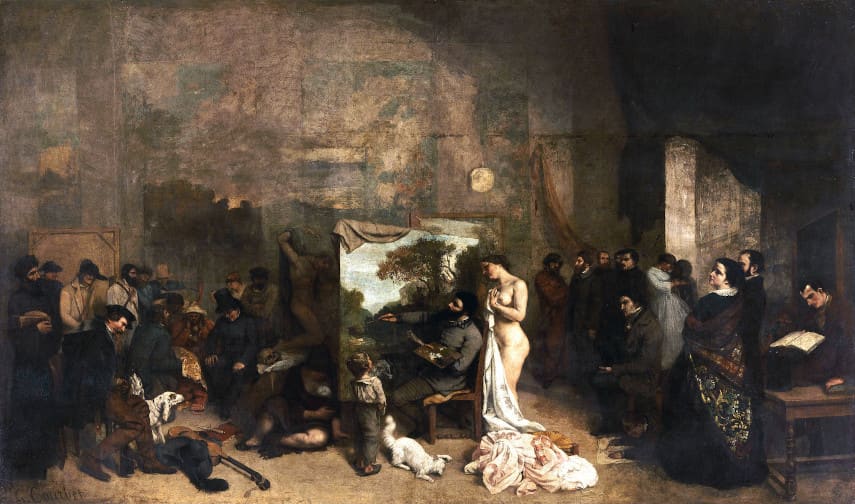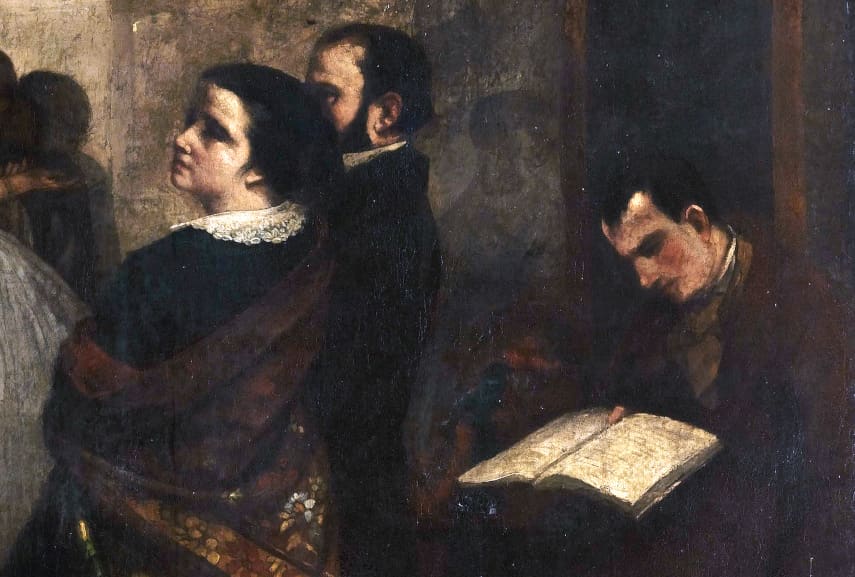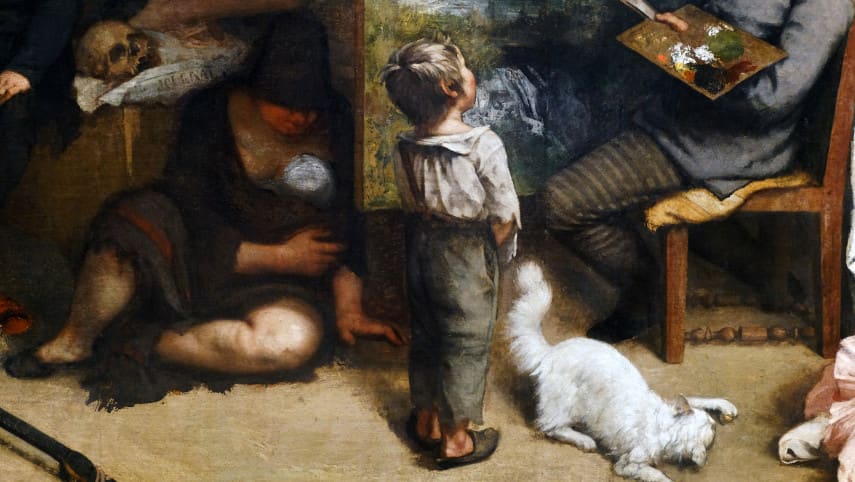Inside The Painter's Studio by Gustave Courbet
The 19th century brought a new generation of painters who explored tradition while developing innovative methods and, essentially, new aesthetics. One of them is the French painter Gustave Courbet, the father of Realism and a firm believer in social transformation. Painting what he saw in reality, Courbet’s inspired the pioneers of Modern art, including the Impressionists and Cubists.
Although he produced a number of landscapes, seascapes, and nudes, most of his paintings reflected his socialist beliefs. By the late 1840s and early 1850s, Courbet gained wider recognition, especially for the painting The Painter's Studio: A real allegory summing up seven years of my artistic and moral life (L'Atelier du peintre) produced in 1855. It is a captivating large-scale painting that, as the artist himself explained, "represents society at its best, its worst, and its average."

The Context of Courbet’s The Painter's Studio
The title of the painting includes a contradiction - the usage of the words real and allegory, which have opposing meanings. In Courbet’s earlier work, the word "real" indicated the painter’s rejection of the heroic or ideal in favor of the actual, but also his interest in showcasing an unpleasant truth in terms of class issues. On the other hand, "allegory" signifies a story or an idea expressed with symbols which has a hidden meaning.
The question remains whether Courbet wanted to engage the audience with the title of his work and encourage them to look for contradictions and double meanings in the image or if it was a self-ironical gesture. Having a short amount of time to finish the work, Courbet abandoned many original plans for the work. This is best seen in the background of the painting. The artist initially planned to paint replications of his works on the back wall of the studio, but due to the lack of time, he used a red-brown preparation color to make the partially finished paintings relatively visible.
The same year this iconic work was produced, the jury of the Paris World Fair accepted eleven paintings by Gustave Courbet for the Exposition Universelle; however, The Painter's Studio was not included. Dissatisfied with their decision, the painter decided to organize his solo exhibition in close proximity to the official exposition and exhibit the work. Eventually, the work received support from some of other artists, including Eugene Delacroix.

The Composition
The figures featured in The Painter's Studio surely represent various influences on Courbet's artistic development. On the left side, the painting features everyday people - the Jewish man and the Irish Woman Courbet saw during his trip to London in 1848, according to a letter Courbet wrote to a French art critic and novelist, Champfelury, describing the composition. There is also a crucified figure painted left of Courbet's easel that was interpreted by some art historians as a symbol of the "death" of the art at the French Royal Academy of Art.
Courbet depicted himself painting a landscape next to a nude female figure, a young boy, and a white cat. The female figure was painted after an 1854 photograph by J. V. de Villeneuve and is believed to be a representation of the art of the Academy or Courbet's Muse for Realism.
The right side of the painting features members of the Parisien elites. The crowd includes the artist’s friends and other figures who had an important role in Courbet’s artistic formation - the artist’s patron, Alfred Bruyas, the above-mentioned Champfleury, Pierre-Joseph Proudhon, the poet Charles Baudelaire, as well as a wealthy pair of art collectors.
These portraits are made after earlier portraits or from photographs. For instance, the portrait of Baudelaire was copied from Courbet's 1847 portrait of the writer. Courbet was in written correspondence with Champfleury during the creation of the famous work, and it is he whom the painter asked for an image of the philosopher and anarchist Proudhon so that he could be included in the painting.
The composition also includes a man with dogs in the foreground. X-rays showed this figure was painted later, but its role is important since as an allegory of the then-current French Emperor, Napoleon III, typically represented with hunting dogs and an iconic mustache. By painting him on the left as a criminal, Courbet expressed his criticism, indicating that Napoleon's ownership of France is an illegal one.

The Significance of Courbet’s The Painter's Studio
By choosing to present himself as painting the Loué River Valley, Courbet didn’t just make an homage to his native Ornans but expressed an act of defiant provincialism aimed at bringing closer the beauty of rural France to the urban elite. Related to that observation is another interesting conclusion made by the notable art historian Linda Nochlin, who interpreted the painting as a manifestation of Courbet's interest in Fourierism, a 19th-century communitarian model of social reorganization most similar to utopian socialism proposed by the French philosopher Charles Fourier.
Besides reflecting Courbet’s social and artistic persuasions, the Painter’s Studio had a significant influence on other, much younger artists. At the time it was presented, it didn’t evoke a wide public interest. However, the painting set Courbet as a lead proponent of the avant-garde tendencies that resonated with the American James Abbott McNeill Whistler and the Impressionist circle.
For instance, Claude Monet incorporated a portrait of Courbet in his celebrated version of Le Déjeuner sur l'herbe from 1865–1866. Courbet's influence is apparent in the work of Edward Hopper, whose Bridge in Paris (1906) and Approaching a City (1946) were interpreted as Freudian echoes of Courbet's The Source of the Loue and The Origin of the World.
Featured image: Gustave Courbet – The Painter’s Studio: A Real Allegory Summing Up Seven Years of My Life as an Artist (detail), 1854-5. Oil on canvas. Height: 361 cm (11.8 ft); Width: 598 cm (19.6 ft). Musee d’Orsay. Image via Creative Commons.
Can We Help?
Have a question or a technical issue? Want to learn more about our services to art dealers? Let us know and you'll hear from us within the next 24 hours.
